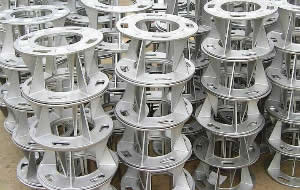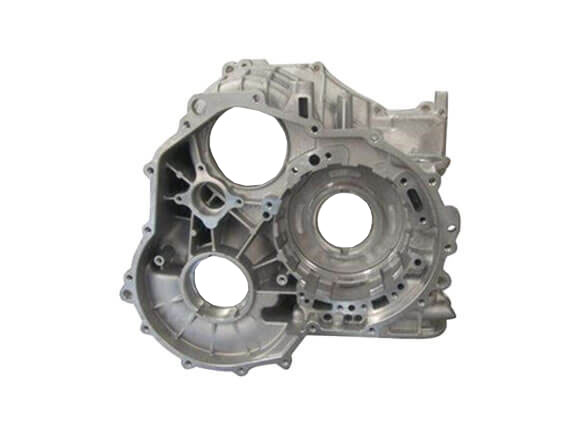Aluminum Casting Explained: Key Facts and Insights for Industry Professionals
Aluminum casting functions as a crucial procedure in modern manufacturing, shaping parts throughout various markets. Its varied methods, such as sand and die casting, accommodate various production demands. The one-of-a-kind residential properties of aluminum alloys improve their applicability, yet tests stay in maintaining quality and efficiency. Recognizing these aspects is crucial for market experts. What are the current developments and best practices that can even more maximize this process?
Overview of Aluminum Casting Processes

Trick components of aluminum casting procedures consist of the preparation of molds, which might be made from sand, metal, or ceramic products, depending upon the intended use. Additionally, temperature level control is important to ensure appropriate melting and solidification of aluminum.
The casting procedure enables detailed designs and can attain high degrees of dimensional precision. As soon as cooled down, the castings might go through finishing operations such as machining or surface area treatment to meet details performance requirements. Generally, aluminum casting acts as a functional production method, efficiently fulfilling the varied needs of different sectors.
Kinds Of Aluminum Casting Techniques
In the domain name of aluminum casting, various techniques are employed to accomplish various outcomes. Sand casting methods give versatility and cost-effectiveness for intricate forms, while die casting procedures offer high precision and efficiency for automation. Understanding these methods is essential for choosing the ideal method based upon job demands.
Sand Casting Methods
Sand casting strategies stand for a basic technique in aluminum casting, where sand is utilized as a mold and mildew material to shape liquified metal. This process involves producing a pattern from the wanted part, which is after that positioned in a sand mixture to create a mold and mildew. The sand is compressed around the pattern, and after elimination, it produces a cavity in the shape of the component. Molten aluminum is poured into this tooth cavity, permitting it to cool and strengthen. One considerable benefit of sand casting is its adaptability; it can suit complicated shapes and large parts. Additionally, the materials made use of are reasonably economical, making it an accessible choice for numerous manufacturing applications in the aluminum sector.
Die Casting Processes
Die casting procedures are a popular technique for shaping aluminum components, utilizing high-pressure strategies to force liquified steel into precisely crafted molds. This process is particularly preferred for its capability to generate complex shapes with tight resistances and a smooth finish. There are two key kinds of die casting: hot chamber and cool chamber. Warm chamber die casting appropriates for metals with reduced melting factors, permitting for faster manufacturing rates. Conversely, cool chamber die casting is optimal for higher melting factor metals, needing a separate melting heating system. Both techniques improve efficiency and reduce material waste, making them vital in automotive, aerospace, and consumer items sectors. Recognizing these processes helps specialists pick one of the most ideal method for their specific applications.
Material Quality of Aluminum Alloys

Stamina and Sturdiness
Strength and resilience are crucial characteristics of aluminum alloys that make them appropriate for numerous casting applications. These materials display a favorable strength-to-weight proportion, enabling the production of lightweight yet robust parts. With respect to tensile strength, details aluminum alloys can be engineered to endure considerable lots without flawing. This residential or commercial property is particularly important in sectors such as aerospace and auto, where efficiency and security are vital. Additionally, aluminum alloys typically keep their mechanical residential or commercial properties under diverse temperature level problems, making sure consistent efficiency. The innate ductility of these alloys additionally permits efficient shaping throughout the casting process, making it easier to generate intricate geometries. On the whole, the strength and longevity of aluminum alloys contribute significantly to their prevalent usage in advanced applications.
Deterioration Resistance Characteristics
While aluminum alloys are treasured for their toughness and lightweight buildings, their rust resistance is one more crucial feature that improves their suitability for different applications. Aluminum naturally develops a protective oxide layer when exposed to wetness, which assists to avoid additional oxidation. This integral home makes aluminum alloys especially useful in atmospheres prone to rust, such as marine and industrial settings. Additionally, various alloy structures can affect resistance levels, with certain alloys specifically engineered to enhance this particular. Therapies like anodizing can additionally boost corrosion resistance by thickening the oxide layer. As a result, comprehending the deterioration resistance of aluminum alloys is vital for industry professionals when selecting materials for tasks requiring longevity and long life in tough atmospheres.
Benefits of Aluminum Casting in Manufacturing
Aluminum casting offers many advantages in production, making it a preferred choice for various markets. One significant benefit is its light-weight nature, which adds to lowered transportation prices and improved energy efficiency in final result. Aluminum's exceptional thermal and electric conductivity boosts capability in applications requiring warmth dissipation or electrical transmission.
The material's capability to be cast into elaborate shapes permits layout adaptability, reducing the demand page for added machining processes. Additionally, aluminum casting displays premium deterioration resistance, bring about longer item life expectancies and reduced upkeep prices.

Common Applications of Aluminum Castings
The adaptability of aluminum casting enables its widespread usage throughout different sectors. Usual applications consist of vehicle components, where light-weight and corrosion-resistant parts, such as engine blocks and transmission real estates, enhance lorry efficiency. In the aerospace field, aluminum spreadings are used for structural components, offering stamina without including significant weight.
Additionally, the electric sector benefits from aluminum spreadings in manufacturing rooms and heat sinks, where thermal conductivity is necessary. The durable goods sector additionally incorporates aluminum spreadings in products like cookware, furnishings, and decorative products, combining looks with capability.
The building market employs aluminum spreadings for building components, home window frames, and components, which give durability and layout flexibility. In general, the varied applications of aluminum spreadings underscore their value in modern manufacturing, adding to improvements in efficiency and product style throughout several areas.
Developments and Technological Advancements
As industries remain to evolve, innovations in aluminum casting innovation are transforming manufacturing processes and product abilities. Innovations in 3D printing and additive production have actually enabled the production of complex geometries that were formerly impossible to attain with conventional techniques. These modern technologies enable fast prototyping, lowering preparations and prices.
In addition, improvements in mold style and materials have improved the casting procedure by increasing performance and minimizing waste. The integration of smart production strategies, such as IoT tools and real-time data analytics, enables much better monitoring and optimization of production criteria, causing better outcomes.
Additionally, developments in aluminum alloys supply enhanced toughness, rust resistance, and lightweight buildings, dealing with the growing demands in automobile and aerospace industries. Jointly, these advancements are not only boosting productivity yet likewise fulfilling the strenuous requirements of modern-day design applications.
Best Practices for Quality Assurance in Aluminum Casting
Making certain top quality results in aluminum casting calls for adherence to ideal techniques that encompass various phases of the production procedure. Initially, thorough product assessment is necessary to validate the high quality of aluminum alloys utilized, as impurities can significantly impact the end product. Carrying out accurate melting and putting techniques decreases issues; maintaining ideal temperatures stops oxidation and advertises uniformity.
Mold and mildew design plays a critical role; using computer-aided design (CAD) can enhance precision and decrease human mistake. Normal surveillance of the cooling process is critical to stay clear of warping and shrinking. Additionally, utilizing non-destructive testing approaches, such as ultrasonic or X-ray examinations, helps identify internal imperfections without harming the parts.
Finally, developing a feedback loop with designers and operators promotes constant enhancement, guaranteeing that quality assurance measures advance together with technical advancements. By adhering to these ideal methods, makers can enhance the reliability and performance of aluminum castings.
Frequently Asked Questions
What Are the Ecological Effects of Aluminum Casting?
The environmental impacts have a peek at this site of aluminum casting include substantial energy intake, greenhouse gas emissions, and prospective water air pollution from shop procedures. Additionally, bauxite mining for aluminum ore can cause habitat destruction and soil deterioration.
Exactly How Does Aluminum Casting Compare to Various Other Metal Casting Processes?
Aluminum casting commonly supplies advantages in lightweight components and corrosion resistance contrasted to various other procedures, such as iron or steel casting, which may give better stamina however result in larger and much less corrosion-resistant products. - aluminum casting
What Are Common Issues in Aluminum Castings and Their Causes?
Common defects in aluminum spreadings consist of porosity, contraction, and inclusions. Causes often stem from inappropriate pouring techniques, insufficient mold layout, or contamination of the molten metal, affecting the last item's integrity and efficiency.
What Safety Preventative Measures Should Be Taken During Aluminum Casting?
During aluminum casting, necessary safety and security preventative measures include putting on protective gear, guaranteeing correct ventilation, keeping a tidy workspace, handling molten steel with care, have a peek at this website and adhering to well-known methods to reduce risks of burns, inhalation dangers, and mishaps.
Exactly How Can I Improve the Performance of My Aluminum Casting Operations?
To boost effectiveness in aluminum casting procedures, one must enhance mold design, simplify product handling, utilize automated processes, perform regular upkeep on tools, and buy staff member training to boost abilities and productivity.
Various techniques exist, aluminum casting encompasses several key processes that cater to various applications and demands. Key elements of aluminum casting processes include the preparation of mold and mildews, which might be made from sand, steel, or ceramic materials, depending on the planned use. Sand casting methods stand for a basic approach in aluminum casting, where sand is made use of as a mold product to form liquified metal. As industries proceed to evolve, technologies in aluminum casting technology are transforming manufacturing procedures and item capabilities. Guaranteeing top quality results in aluminum casting requires adherence to ideal techniques that incorporate various stages of the manufacturing process.